Ivanhoe and Zijin Mining have made excellent progress
developing the Kakula Copper Mine in D.R. Congo, with initial
production on track for Q3 2021
Capacity of Kakula’s processing plant modules increased by 26%,
from 3.0 Mtpa to 3.8 Mtpa each, significantly boosting projected
early-stage copper production
Additional mining crews to be added at Kakula to increase
pre-production ore stockpile and to position the mine
to accelerate expansion of the second phase of development
Kakula’s initial capital costs now estimated at $1.3 billion,
an increase of 18%, including expanded plant capacity, additional
mining fleets and pre-production ore stockpile
Initial mineral resource estimate and scoping study test work
underway for the latest high-grade discovery at Kamoa-Kakula ─
the Kamoa North Bonanza Zone
Drilling extends the new Kamoa Far North extension discovery on
Ivanhoe’s 100%-owned Western Foreland licences to at least 800
metres and the mineralized trend remains open
TORONTO, CANADA ‒ Ivanhoe Mines (TSX: IVN; OTCQX: IVPAF) today announced its financial results for the quarter ended September 30, 2019. All figures are in U.S. dollars unless otherwise stated.
Ivanhoe Mines is a Canadian mining company focused on advancing its three mine-development projects in Southern Africa: the Platreef palladium-platinum-nickel-copper-gold-rhodium discovery in South Africa; the Kamoa-Kakula copper discovery in theDemocratic Republic of Congo (DRC); and the extensive upgrading of the historic Kipushi zinc-copper-lead-germanium mine, also in the DRC. The company continues to explore for new copper discoveries on its wholly-owned Western Foreland exploration licences, adjacent to the Kamoa-Kakula mining licence.
HIGHLIGHTS
- CITIC Metal Africa Investments Limited’s (CITIC Metal Africa) C$612 million ($459 million) second equity investment in Ivanhoe Mines at C$3.98 per share successfully closed on August 16, 2019. The investment is an integral part of Ivanhoe and CITIC Metal’s long-term strategic cooperation and brought CITIC Metal’s investment in Ivanhoe Mines in less than one year to more than $1.0 billion. On the same date, CITIC Metal’s Vice President Manfu Ma was appointed to Ivanhoe’s Board of Directors, increasing CITIC Metal’s appointees to Ivanhoe’s 11-person Board to three.
- Also on August 16, 2019, Ivanhoe’s joint-venture partner at Kamoa-Kakula, Zijin Mining Group Co., Ltd. (Zijin Mining), provided additional proceeds to Ivanhoe of C$67 million ($50 million) also at C$3.98 per share through the exercise of its anti-dilution rights. Zijin Mining’s Chairman Chen Jinghe was elected to Ivanhoe’s Board on June 28, 2019.
- CITIC Metal Africa and Zijin Mining are each subject to long-term standstill agreements with Ivanhoe Mines that limit the maximum number of shares each may acquire, which in the case of CITIC Metal Africa is 29.9% until January 8, 2023, and in the case of Zijin currently is 9.9% until December 7, 2026, beyond which each can only acquire shares on a consensual, negotiated basis with Ivanhoe Mines until the standstills expire. Zijin Mining’s maximum allowable shareholding under its standstill will increase to 13.88% on completion of the rebalancing transaction announced by Ivanhoe on October 8, 2019, but the standstill expiry date will remain at December 7, 2026.
- On October 8, 2019, Ivanhoe and Zijin announced the employment of a stand-alone executive team to take Kamoa-Kakula to commercial production. Mark Farren, formerly Ivanhoe’s Executive Vice President, Operations, was appointed as the Chief Executive Officer of the Kamoa-Kakula Copper Joint Venture. Joining Mr. Farren on Kamoa-Kakula’s new executive management team will be Dr. Yong Chen of Zijin Mining, as Chief Operating Officer.
- In two concurrent moves to further enhance Ivanhoe’s development and operating capabilities, Louis Watum, Ivanhoe’s DRC country manager, was appointed President of the Board of Directors of Kamoa Copper SA, the DRC operating company of the joint venture between Ivanhoe Mines, Zijin Mining, Crystal River and the Government of the Democratic Republic of Congo that is developing the Kamoa-Kakula Project. South African mining veteran Warwick Morley-Jepson was appointed as Ivanhoe’s new Chief Operating Officer, assuming the duties formerly held by Mr. Farren.
- On July 29, 2019, Ivanhoe announced that drilling on its 100%-owned Western Foreland licences, immediately north of the Kamoa-Kakula mining licence, had discovered the extension of the Kamoa Far North high-grade shallow copper corridor on Ivanhoe’s wholly-owned licences for at least 400 metres. Additional drilling has extended this strongly mineralized corridor to at least 800 metres. Sixteen holes now have been completed this year in this new high-grade target area and assays are pending.
- On July 29, 2019, Ivanhoe announced assays from 19 new drill holes at the latest high-grade discovery at Kamoa-Kakula ─ the Kamoa North Bonanza Zone. Multiple, thick drill intercepts of more than 10% copper were recorded at the new discovery, including 13.80% over 15.50 metres in the central discovery area. Work is underway to prepare an initial mineral resource estimate for the Bonanza Zone, as well as geotechnical, hydrogeological and metallurgical test work needed for mine planning.
- The controlling east-west striking structure thought to be responsible for the massive copper sulphide mineralization in the Kamoa North Bonanza Zone is visible as a lineament on airborne magnetic images and can be traced over a distance of up to 20 kilometres. It trends west onto the adjacent Western Foreland exploration licences that are 100%-owned by Ivanhoe Mines.
- Development of the Kakula Mine, the first of multiple, planned mining areas at Kamoa-Kakula, is making excellent progress. The first underground access drives intersected Kakula’s initial high-grade ore (+3% copper) in late August, then intersected an even higher grade zone (approximately 6% copper) in late October as the drives advance towards mining zones of +8% copper in the center of the Kakula deposit. Ivanhoe and its joint-venture partner Zijin Mining are advancing rapidly on earthworks for the processing plant and other surface infrastructure. The joint venture has issued purchase orders for the long-lead mining and processing equipment. Initial copper concentrate production from the Kakula Mine currently is scheduled for the third quarter of 2021.
- Following the completion of basic engineering and procurement, as part of the forthcoming Kakula DFS, Kakula’s initial processing plant capacity has increased from 3.0 Mtpa to 3.8 Mtpa. The expansion in initial plant capacity requires increasing the underground mining crews in 2020 from 11 to 14 to ensure sufficient mining operations to feed the expanded plant and create pre-production stockpiles of approximately 1.5 million tonnes of high-grade ore and an additional 700,000 tonnes of lower-grade material (approximately 1% to 3% copper). This should allow the plant to ramp up quickly and maintain a steady state throughput of 3.8 Mtpa.
- The project team has recently completed basic engineering design and costing for Kakula’s initial mine and underground infrastructure, the first concentrator module and associated surface infrastructure. The updated estimate of the project’s initial capital costs is approximately $1.3 billion (from January 1, 2019), which assumes commissioning of the processing plant in Q3 2021. The capital costs incurred by the Kamoa-Kakula joint venture during the first nine months of 2019 were $182.5 million.
- Other engineering and construction activities underway at Kamoa-Kakula include the refurbishment of six turbines at the Mwadingusha hydro-electric power plant and associated 220-kilovolt infrastructure to supply the mine with clean hydro-power, construction of a permanent road between the mine site and the Kolwezi airport, construction of the first phase of accommodations for 1,000 employees and contractors, and earthworks for the processing plant and other surface infrastructure.
- An independent preliminary economic assessment (PEA) issued in February 2019 indicates that Kamoa-Kakula has a potential production rate of at least 18 Mtpa. Once this expanded rate is achieved, Kamoa-Kakula is projected to become the world’s second largest copper mine, with peak annual production of more than 700,000 tonnes of copper.
- At the Kipushi mine redevelopment project in the DRC, the definitive feasibility study (DFS), which will update and refine the findings of the PFS issued in December 2017, is being reviewed by Ivanhoe’s engineering team who continues to work toward completion. Similar to the PFS, the DFS will focus on the initial mining of Kipushi’s Big Zinc Zone.
- At the Platreef mine development project in South Africa, the project’s first shaft (Shaft 1) has been sunk to a depth of more than 953 metres below surface. The 950-metre-level station development for Shaft 1 is well underway, with completion of the shaft to a final depth of approximately 1,000 metres planned for mid-2020.
- The concrete foundation for Platreef’s Shaft 2 headframe was completed in mid-July. Shaft 2 will have an internal diameter of 10 metres and will be equipped with two Koepe winding plants, one equipped with 40-tonne rock-hoisting skips providing the mine with a total capacity to hoist six million tonnes of ore per year – the single largest hoisting capacity at any mine in Africa.
- Palladium prices continued to surge to new record highs in the third quarter, topping $1,800 an ounce as stricter air-quality rules boost demand for the metal used in vehicle pollution-control devices. The price increase has propelled Ivanhoe’s Platreef Project ‘metals-price basket’ to a new, multi-year high.
- Ivanhoe is investigating an alternative early production plan for the Platreef Project, targeting significantly lower initial capital, to accelerate first production by using Shaft 1 as the mine’s initial production shaft, followed by expansions to the production rate as outlined in the DFS.
- Ivanhoe Mines deeply regrets to report that a fatal accident involving a contractor’s employee occurred at the Kamoa-Kakula Project in September. The accident involved a civil contractor at a surface cement batching plant. The Kamoa-Kakula senior management team worked with the DRC authorities to facilitate their investigation of the accident. The Kamoa-Kakula Project implemented additional safety measures to prevent such an accident from recurring. This is the first fatality at the Kamoa-Kakula Project. The project had gone more than 7.5 years without a lost-time injury prior to the fatal injury.
- At the end of Q3 2019, Kamoa-Kakula reached 120,501 work hours free of a lost-time injury, Kipushi 1.488 million work hours free of a lost-time injury, and Platreef 214,111 work hours free of a lost-time injury.
Principal projects and review of activities
1. Platreef Project
64%-owned by Ivanhoe Mines
South Africa
The Platreef Project is owned by Ivanplats (Pty) Ltd, which is 64%-owned by Ivanhoe Mines. A 26% interest is held by Ivanplats’ historically-disadvantaged, broad-based, black economic empowerment (B-BBEE) partners, which include 20 local host communities with approximately 150,000 people, project employees and local entrepreneurs.In Q2 2019, Ivanplats reached Level 2 contributor status in its verification assessment on the B-BBEE scorecard.A Japanese consortium of ITOCHU Corporation, Japan Oil, Gas and Metals National Corporation and Japan Gas Corporation owns a 10% interest in Ivanplats, which it acquired in two tranches for a total investment of $290 million.
The Platreef Project hosts an underground deposit of thick, platinum-group metals, nickel, copper and gold mineralization on the Northern Limb of the Bushveld Igneous Complex in Limpopo Province, approximately 280 kilometres northeast of Johannesburg and eight kilometres from the town of Mokopane.
On the Northern Limb, platinum-group metals mineralization is hosted primarily within the Platreef, a mineralized sequence that is traced more than 30 kilometres along strike. Ivanhoe’s Platreef Project, within the Platreef’s southern sector, is comprised of two contiguous properties: Turfspruit and Macalacaskop. Turfspruit, the northernmost property, is contiguous with, and along strike from, Anglo Platinum’s Mogalakwena group of mining operations and properties.
Since 2007, Ivanhoe has focused its exploration and development activities on defining and advancing the down-dip extension of its original discovery at Platreef, now known as the Flatreef Deposit, which is amenable to highly mechanized, underground mining methods. The Flatreef area lies entirely on the Turfspruit and Macalacaskop properties, which form part of the company’s mining right.
Health and safety at Platreef
As at the end of Q3 2019, the Platreef Project reached a total of 214,111 lost-time, injury-free hours worked in accordance with South Africa’s Mine Health and Safety Act, and Occupational Health and Safety Act. Unfortunately a lost-time injury (LTI) occurred in July 2019 after the project had reached 14 months without a LTI. The Platreef Project continues to strive toward its workplace objective of an environment that causes zero harm to employees, contractors, sub-contractors and consultants.
Platreef Project showing the Shaft 1 headframe and the stockpile of development rock from ongoing shaft-sinking work in Shaft 1.
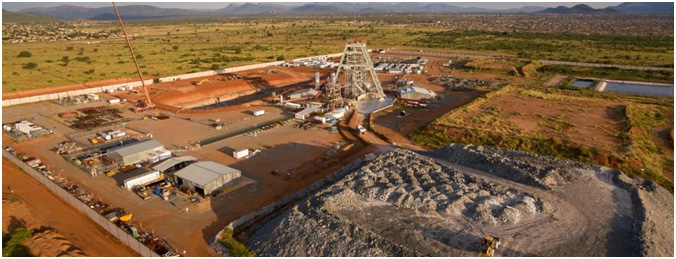
Platreef alternative production plan
Palladium prices continue to surge to new record highs, topping $1,800 an ounce as stricter air-quality rules boost demand for the metal used in vehicle pollution-control devices. The price increase has propelled Ivanhoe’s Platreef Project ‘metals-price basket’ to a new, multi-year high.
Ivanhoe Mines is investigating an alternative production plan for the Platreef Project, targeting significantly lower initial capital, to accelerate first production by using Shaft 1 as the mine’s initial production shaft. This plan will focus on initially targeting the development of mining zones accessible from Shaft 1 and maximizing the hoisting capacity of this shaft, followed by expansions to the production rate as outlined in the DFS.
Shaft 1 now extends to a depth of more than 953 metres below surface
Shaft 1 reached the top of the high-grade Flatreef Deposit (T1 mineralized zone) at a depth of 780.2 metres below surface in Q3 2018 and has since been extended to a depth of more than 950 metres below surface. The thickness of the mineralized orebody (T1 and T2 mineralized zones) at Shaft 1 is 29 metres, with grades of platinum-group metals ranging up to 11 grams per tonne (g/t) 3PE (platinum, palladium and rhodium) plus gold, as well as significant quantities of nickel and copper. The 29-metre intersection yielded approximately 3,000 tonnes of ore, estimated to contain more than 400 ounces of platinum-group metals. The ore is stockpiled on surface for further metallurgical sampling.
The 750-metre-level and 850-metre-level stations have both been completed with the 950-metre-level station currently in development. Development is being carried out on the north drift of the 950-metre-level to accommodate a temporary refuge bay and rock handling arrangements facilitating early development from Shaft 1.
The final shaft bottom depth has been revised to 1,000 metres below surface in order to cater for a long-term life of mine spillage arrangement. This projected final depth is expected to be reached in mid-2020. The three development stations will provide initial, underground access to the high-grade orebody, enabling mine development to proceed concurrently with the construction of Shaft 2.
Tumelo Maselela, Mining Engineer, marking off shotholes in preparation for the next drilling cycle.
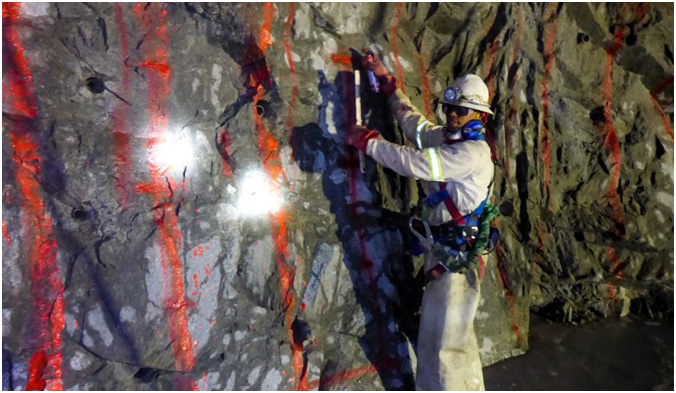
Rock-drill operators preparing to drill shotholes for the next development blast at the 950-metre-level station.

Shaft 2 box cut and concrete foundation completed in July
Shaft 2, to be located approximately 100 metres northeast of Shaft 1, will have an internal diameter of 10 metres. It will be lined with concrete and sunk to a planned, final depth of more than 1,104 metres below surface. It will be equipped with two Koepe winding plants, one equipped with 40-tonne rock-hoisting skips capable of hoisting a total of six million tonnes of ore a year – the single largest hoisting capacity at any mine in Africa.
The headgear for the permanent hoisting facility was designed by South Africa-based Murray & Roberts Cementation. The box-cut excavation to a depth of approximately 29 metres below surface, including the concrete foundation, has been successfully completed and will form the foundation of the 103-metre-tall concrete headgear that will house the shaft’s permanent hoisting facilities and support the shaft collar.Work on Shaft 2 has been temporarily deferred while the company completes its review of the alternative production plan using Shaft 1 as the mine’s initial production shaft.
Underground mining to incorporate highly productive, mechanized methods
The mining zones in the current Platreef mine plan occur at depths ranging from approximately 700 metres to 1,200 metres below surface.
Planned mining methods will use highly productive, mechanized methods, including long-hole stoping and drift-and-fill mining. Each method will utilize cemented backfill for maximum ore extraction. As per the DFS, the ore will be hauled from the stopes to a series of internal ore passes and transferred to the bottom of Shaft 2 via inter-level ore passes, where it will be crushed and then hoisted to surface.
Figure 1: Schematic section of the Platreef Mine, showing Flatreef’s T1 and T2 thick, high-grade mineralized zones (red and dark orange), underground development work completed to date in shafts 1 and 2 (white) and planned development work (gray).
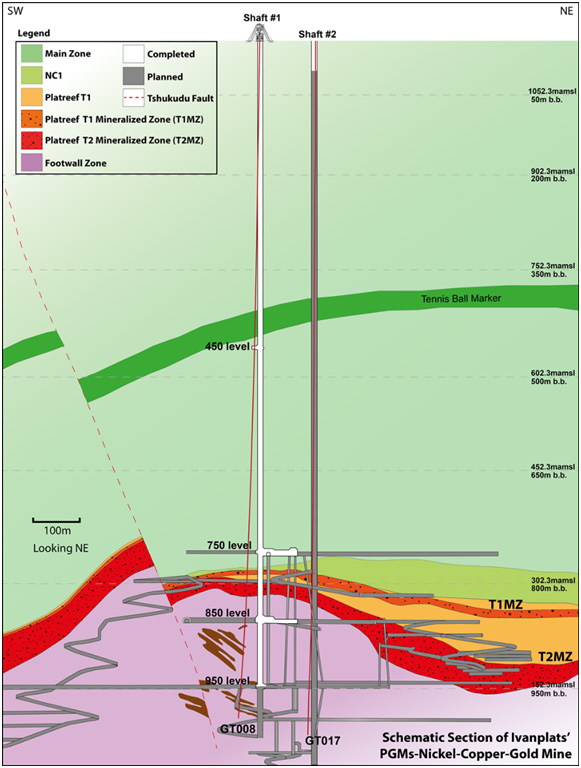
Development of human resources and job skills
The Platreef Project’s Social and Labour Plan (SLP), towards which it pledged a total of R160 million ($11 million) during the past five years, expires in November 2019. That approved plan included R67 million ($4 million) for the development of job skills among local residents and R88 million ($6 million) for local economic development projects. Consultation regarding the project’s second SLP is in the final stages.
The Ivanplats team celebrated Arbour Day by planting trees near the Platreef project site.
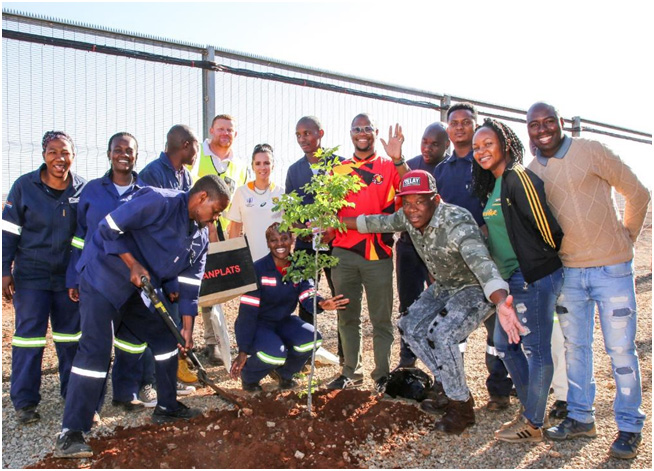
2. Kipushi Project
68%-owned by Ivanhoe Mines
Democratic Republic of Congo
The Kipushi copper-zinc-germanium-lead mine, in the Democratic Republic of Congo, is adjacent to the town of Kipushi and approximately 30 kilometres southwest of Lubumbashi. It is located on the Central African Copperbelt, approximately 250 kilometres southeast of the Kamoa-Kakula Project and less than one kilometre from the Zambian border. Ivanhoe acquired its 68% interest in the Kipushi Project in November 2011; the balance of 32% is held by the state-owned mining company, La Générale des Carrières et des Mines (Gécamines).
Health, safety and community development
At the end of Q3 2019, the Kipushi Project reached a total of 1,488,337 work hours free of a lost-time injury.
The Kipushi Project operates a potable-water station to supply the municipality of Kipushi with water. This includes power supply, disinfectant chemicals, routine maintenance, security and emergency repair of leaks to the primary reticulation. The Kipushi Project also installed and commissioned new overhead powerlines to the pump station. Other community development projects continued during Q3 2019 included the Kipushi women’s literacy project, the sewing training centre project and the upgrading of the Mungoti School in Kipushi.
Upgrading work now is complete at the Mungoti community school that adjoins the Kipushi Mine. The upgrading project was funded by the Kipushi Mine.
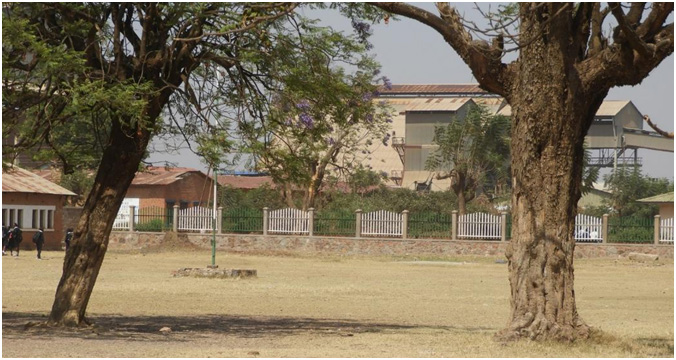
Pre-feasibility study for Kipushi completed in December 2017 and definitive feasibility study in final stages of completion
The Kipushi Project’s PFS, announced by Ivanhoe Mines on December 13, 2017, anticipated annual production of an average of 381,000 tonnes of zinc concentrate over an 11-year, initial mine life at a total cash cost of approximately $0.48 per pound (lb) of zinc.
Highlights of the PFS, based on a long-term zinc price of $1.10/lb include:
- After-tax net present value (NPV) at an 8% real discount rate of $683 million.
- After-tax real internal rate of return (IRR) of 35.3%.
- After-tax project payback period of 2.2 years.
- Pre-production capital costs, including contingency, estimated at $337 million.
- Existing surface and underground infrastructure allows for significantly lower capital costs than comparable greenfield development projects.
- Life-of-mine average planned zinc concentrate production of 381,000 dry tonnes per annum, with a concentrate grade of 59% zinc, is expected to rank Kipushi, once in production, among the world’s largest zinc mines.
All figures are on a 100%-project basis unless otherwise stated. Estimated life-of-mine average cash cost of $0.48/lb of zinc is expected to rank Kipushi, once in production, in the bottom quartile of the cash-cost curve for zinc producers internationally.
The project team continues to work towards the completion of the Kipushi Project’s definitive feasibility study (DFS).
Kaboya Geullord installing brackets along Kipushi’s T4 conveyor belt that will transport ore from the underground mine to surface.
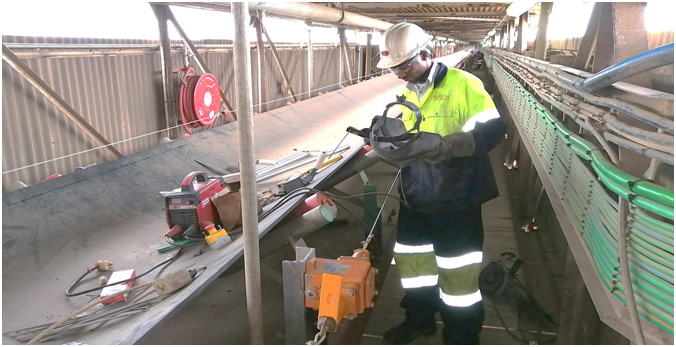
Geology and exploration
Geological work in Q1 2019 was focused on obtaining additional information required for the DFS, as well as planning the geological delineation-drilling and grade-control program for underground mine development. The design criteria for the delineation drilling will target areas along the edge of the Big Zinc, which presently are inaccessible from the historic workings. No new geological and exploration work was conducted during Q2 or Q3 2019.
Project development and infrastructure
Significant progress has been made in modernizing the Kipushi Mine’s underground infrastructure as part of preparations for the mine to resume commercial production, including upgrading a series of vertical mine shafts to various depths, with associated head frames, as well as underground mine excavations and infrastructure. A series of crosscuts and ventilation infrastructure still is in working condition and have been cleared of old materials and equipment to facilitate modern, bulk mechanized mining. The underground infrastructure also includes a series of pumps to manage the mine’s water levels, which now are easily maintained at the bottom of the mine.
Shaft 5 is eight metres in diameter and 1,240 metres deep. It now has been upgraded and re-commissioned. The main personnel and material winder has been upgraded and modernized to meet international industry standards and safety criteria. The Shaft 5 rock-hoisting winder now is fully operational with new rock skips, new head- and tail-ropes, and attachments installed. The two newly manufactured rock conveyances (skips) and the supporting frames (bridles) have been installed in the shaft to facilitate the hoisting of rock from the main ore and waste storage silos feeding rock on the 1,200-metre level.
The main haulage way on the 1,150-metre level, between the Big Zinc access decline and Shaft 5 rock load-out facilities, has been resurfaced with concrete so the mine now can use modern, trackless, mobile machinery. A new truck-tipping bin, which feeds into the large-capacity rock crusher located directly below, has been installed on this level. The old winder at P2 Shaft has been removed and construction of the new foundation, along with assembly and installation of the new modern winder, has been completed and fully commissioned after passing safety inspection and testing procedures.
With the underground upgrading program nearing completion, the project’s focus now will shift to upgrading Kipushi’s surface infrastructure to handle and process Kipushi’s high-grade zinc and copper resources.
Upgrading and cleaning completed at Kipushi’s 1,132-metre-level workshop.
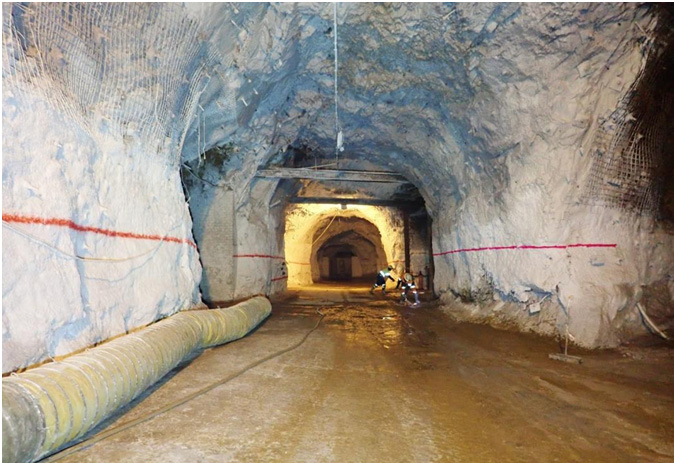
3. Kamoa-Kakula Project
39.6%-owned by Ivanhoe Mines
Democratic Republic of Congo
The Kamoa-Kakula Project, a joint venture between Ivanhoe Mines and Zijin Mining, has been independently ranked as the world’s fourth largest copper deposit by international mining consultant Wood Mackenzie. The project is approximately 25 kilometres west of the town of Kolwezi and about 270 kilometres west of Lubumbashi.
Ivanhoe sold a 49.5% share interest in Kamoa Holding to Zijin Mining in December 2015 for an aggregate consideration of $412 million. In addition, Ivanhoe sold a 1% share interest in Kamoa Holding to privately-owned Crystal River for $8.32 million – which Crystal River will pay through a non-interest-bearing, 10-year promissory note. Since the conclusion of the Zijin transaction in December 2015, each shareholder has been required to fund expenditures at the Kamoa-Kakula Project in an amount equivalent to its proportionate shareholding interest in Kamoa Holding.
A 5%, non-dilutable interest in the Kamoa-Kakula Project was transferred to the DRC government on September 11, 2012 for no consideration, pursuant to the 2002 DRC mining code. Following the signing of an agreement with the DRC government in November 2016, in which an additional 15% interest in the Kamoa-Kakula Project was transferred to the DRC government, Ivanhoe and Zijin Mining now each hold an indirect 39.6% interest in the Kamoa-Kakula Project, Crystal River holds an indirect 0.8% interest and the DRC government holds a direct 20% interest. Kamoa Holding holds an 80% interest in the project.
Figure 2: Kamoa-Kakula mining licence, showing the Kamoa North Bonanza and Kamoa Far North zones, the new Kamoa Far North extension discovery on Ivanhoe’s 100%-owned exploration licences, and the planned mines at Kakula and Kansoko.
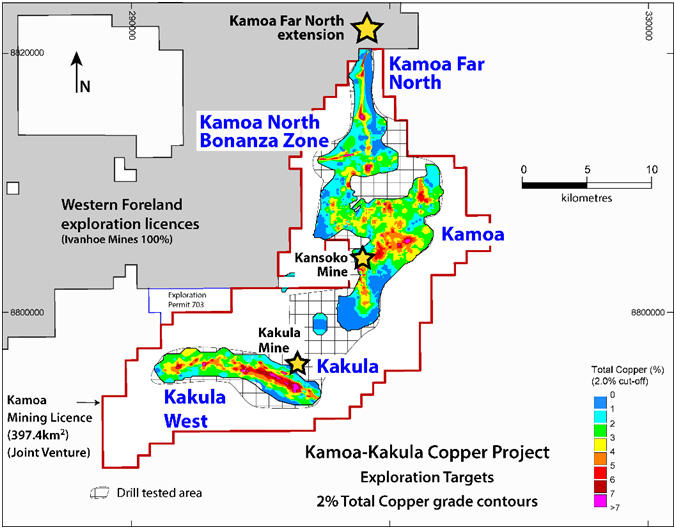
Health and safety at Kamoa-Kakula
Ivanhoe Mines deeply regrets to report that a fatal accident involving a contractor’s employee occurred at the Kamoa-Kakula Project in September. The accident involved a civil contractor at a surface cement batching plant. The Kamoa-Kakula senior management team worked with the DRC authorities to facilitate their investigation of the accident. The Kamoa-Kakula Project implemented additional safety measures to prevent such an accident from recurring. This is the first fatality at the Kamoa-Kakula Project. The project had gone more than 7.5 years without a lost-time injury. At the end of Q3 2019, the project reached 120,501 work hours free of a lost-time injury.
PFS for Kakula and updated PEA for an expanded Kamoa-Kakula production rate of 18 Mtpa announced
On February 6, 2019, Ivanhoe announced the results from the Kakula 2019 PFS. The study assesses the potential development of the Kakula Deposit as a 6 Mtpa mining and processing complex. The Kakula mill would be constructed in two modules of 3.0 Mtpa each as the mining operations ramp-up to full production of 6.0 Mtpa. The life-of-mine production scenario provides for 119.7 million tonnes to be mined at an average grade of 5.48% copper, producing 9.8 million tonnes of high-grade copper concentrate, containing approximately 12.4 billion pounds of copper. All figures are on a 100%-project basis unless otherwise stated.
On March 22, 2019, Ivanhoe filed an updated NI 43-101 technical report for the Kamoa-Kakula Copper Project covering the independent pre-feasibility studies for the development of the Kakula and Kansoko copper mines, and an updated, expanded preliminary economic assessment for the overall integrated development plan for the project. The report, titled “Kamoa-Kakula Integrated Development Plan 2019”, is available on the company’s website and under the company’s SEDAR profile at www.sedar.com.
Highlights of the PFS, based on a consensus, long-term copper price of $3.10/lb include:
- Very high-grade, stage-one production is projected to have a grade of 7.1% copper in the second year of production and an average grade of 6.4% copper over the initial 10 years of operations, resulting in estimated average annual copper production of 291,000 tonnes.
- Annual copper production estimated at 360,000 tonnes in year four.
- Initial capital cost, including contingency, estimated at $1.1 billion.
- Average total cash cost of $1.11/lb of copper during the first 10 years, inclusive of royalties.
- After-tax NPV, at an 8% discount rate, of $5.4 billion.
- After-tax internal rate of return (IRR) of 46.9% and a payback period of 2.6 years.
- Kakula is expected to produce a very high-grade copper concentrate in excess of 55% copper, with extremely low arsenic levels.
Ivanhoe also announced an updated independent PEA for an expanded Kamoa-Kakula production rate of 18 Mtpa, supplied initially by a 6 Mtpa mine at Kakula, followed by two 6 Mtpa mines, one at Kansoko and the other at Kakula West, and a world-scale direct-to-blister smelter.
Figure 3: Kakula’s conceptual surface layout, showing the ore stockpiles (blue circles) and processing plant (yellow box).
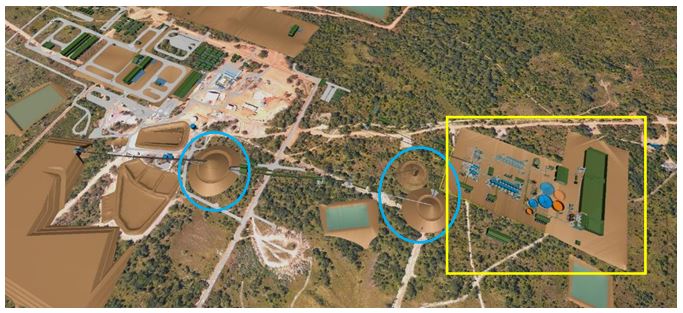
Highlights of the PEA, based on a consensus, long-term copper price of $3.10/lb include:
- Very high-grade initial phase projected to have a grade of 7.1% copper in the second year of production and an average grade of 5.7% copper during the first 10 years of operations, resulting in estimated average annual copper production of 386,000 tonnes.
- Recovered copper production estimated at 740,000 tonnes in year 12, which would rank the Kamoa-Kakula Project as the second largest copper producer in the world.
- Initial capital cost, including contingency, is $1.1 billion, with subsequent expansions at Kansoko, Kakula West, and other mining areas, as well as the smelter, to be funded by cash flows from the Kakula Mine.
- Average total cash costs of $0.93/lb of copper during the first 10 years, including sulphuric acid credits.
- After-tax NPV, at an 8% discount rate, of $10.0 billion.
- After-tax IRR of 40.9% and a payback period of 2.9 years.
Figure 4: Kamoa-Kakula 18 Mtpa PEA long-term development plan.
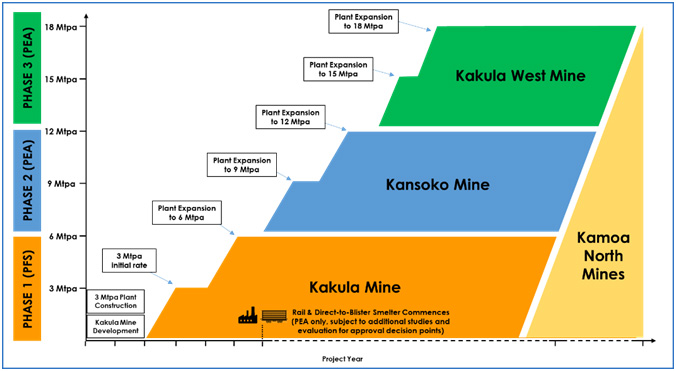
Figure by OreWin 2019.
Figure 5: Projected 18 Mtpa Kamoa-Kakula PEA production (year-12 peak copper production shown) compared to the world’s projected top 20 producing mines in 2025 by paid copper production.
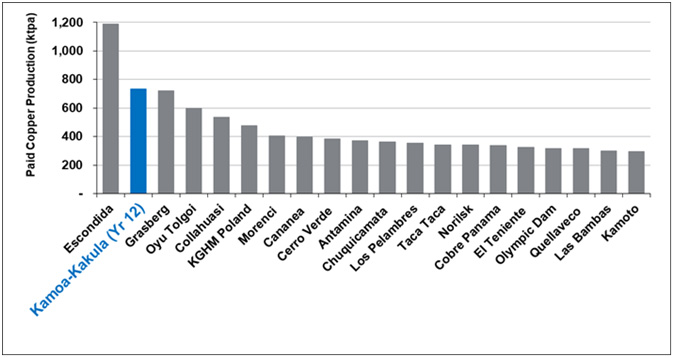
Note: Kamoa-Kakula 2019 PEA production based on projected peak copper production (which occurs in year 12) of the 18 Mtpa alternative development option. Source: Wood Mackenzie (based on public disclosure; the Kakula 2019 PFS has not been reviewed by Wood Mackenzie).
Kakula’s initial processing plant capacity increased by 26% from 3.0 Mtpa to 3.8 Mtpa, boosting projected early-stage copper production
An independent definitive feasibility study (DFS) for the Kakula Mine is underway with an expected completion date of mid-2020. At the same time, Ivanhoe expects to issue an updated preliminary economic assessment for the expanded Kamoa-Kakula combined production scenario that will include an updated Mineral Resource estimate for Kamoa North, including the initial Mineral Resource estimate for the Kamoa North Bonanza Zone.
The forthcoming Kakula DFS will incorporate detailed design, engineering and procurement, which is largely complete, with plans to increase the initial processing plant ore capacity by approximately 26% from 3.0 Mtpa to 3.8 Mtpa.
Based on the results of the February 2019 PFS, Kakula’s average feed grade over the first five years of operations is projected to be 6.8% copper, and 5.5% copper on average over a 25-year mine life. An increase in the initial processing plant throughput is expected to result in improved cash flows, which may be used to accelerate subsequent expansions.
Additional mining crews to be added at Kakula to increase pre-production ore stockpiles and to position the mine to accelerate commencement of the second phase of development
The expansion in initial plant capacity from 3.0 Mtpa to 3.8 Mtpa would require increasing the underground mining crews in 2020 from 11 to 14 to ensure sufficient mining operations to feed the expanded plant throughput. This would have the benefit of producing a larger surface stockpile of ore prior to the scheduled commissioning of the processing plant, as well as accelerating the mine development schedule, providing the opportunity to bring forward the commencement of the second phase of development at Kakula. The second 3.8 Mtpa plant module will be fed from the Kakula mine at a planned full production rate of 6 Mtpa. Further study work will determine the amount of tonnes to be sourced from the Kansoko Mine, or elsewhere, to maximize the full milling capacity of 7.6 Mtpa. Any plans to accelerate the second module of Kakula’s processing plant would be subject to securing the necessary project-level financing.
Kakula’s original 3.0 Mtpa first processing plant module has already been redesigned during the basic engineering phase to a nameplate capacity of 3.8 Mtpa. Purchase orders have been placed for all major long-lead time mechanical equipment, plant earthworks are well advanced, and plant civil works have started. The contract for the SMPP (structural, mechanical, piping and platework) supply and erection portion of the plant construction recently has been awarded. The capital cost estimate related to the construction of the processing plant has been estimated to a basic engineering level of accuracy and is thus well defined.
The current updated estimate of the project’s initial capital costs is approximately $1.3 billion as of January 1, 2019, which assumes commissioning of the first processing plant module in Q3 2021 and includes expanded plant capacity and pre-production ore stockpiles.
The capital costs incurred by the Kamoa-Kakula joint venture during the first nine months of 2019 were $182.5 million, of which $60.5 million was spent on the Kakula declines and mine development.
Ivanhoe will fund its share of approximately 40% of the initial capital costs, plus it will fund its share of capital associated with the 20% carried interest owned by the Government of the DRC, a portion which will be repaid through future cash flows from the project. Ivanhoe expects that it will continue to have sufficient cash resources or project-related financing options available to cover its share of the potential increase in initial capital costs.
More than five kilometres of underground development was completed in the first nine months of 2019 as the project tracks towards first production in Q3 2021
The underground development work at Kakula is being performed by mining crews operating large-capacity, semi-autonomous mining equipment, such as jumbo drilling rigs and 50-tonne trucks. More than five kilometres of underground development was completed in the nine months ended September 30, 2019.
Development ore is being stockpiled on surface near the site of the concentrator plant. This ore will be used for plant commissioning as well as supplying any gap in the production build-up once the concentrator is operational.
Kakula’s underground development and production five-year plan showing more than five kilometres of development work completed to date (purple with access from the northern declines and yellow with access from the southern decline).
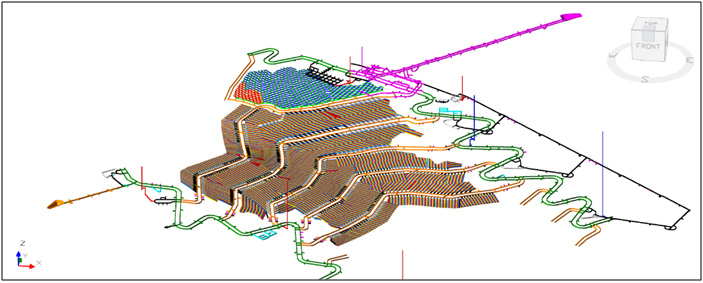
A 3-D model of Kakula’s underground transfer bins that currently are under development. The bins will transfer ore from the 50-tonne haulage dump trucks to the conveyor belt for transportation to surface.
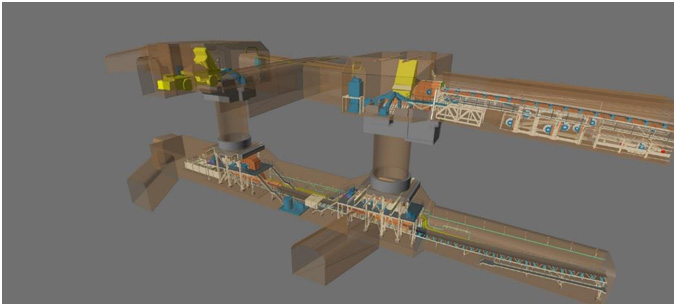
Mine access drives 1 and 2 (interconnected, parallel tunnels that will provide access to ore zones) continue to progress, with access drive 2 having reached the high-grade zone.
The number of underground mining crews has increased from three at the start of the third quarter, to six now working at Kakula. The project will continue to add additional crews over the next 12 months to further accelerate development. Ventilation Shaft 1 has been fully commissioned and work on ventilation shafts 2 and 3 is well advanced, with underground access for both having been achieved and pilot drilling started. Construction of the underground rock handling system (tips, bins and conveyors) is progressing well and is targeted for completion in Q2 2020. Work on Kakula’s main decline dam and pumping station has been completed, and work on the main decline bottom dam is well advanced.
By the end of September 2019, 571 metres of development had been completed at the southern ventilation decline, which will facilitate the acceleration of critical early mine development.
More than five kilometres of underground development have been completed to date at Kakula and the pace will increase as more mining crews are added. Access tunnels measure six metres by six metres, allowing access for large-capacity LHD loaders and 50-tonne haulage trucks.
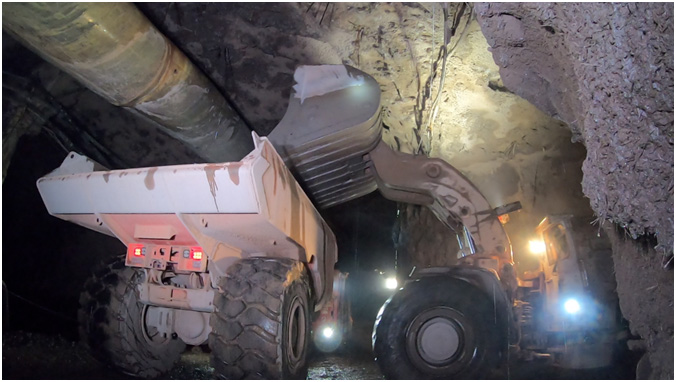
Basic engineering and early-works engineering at Kakula now complete
The basic engineering design and costing for the initial five-years has been completed. The cost and design of the plant, infrastructure and mining areas have been reviewed. The basic engineering package also provided a detailed capital cost estimate by which the project costs can be controlled and will be included in the independent definitive feasibility study, which will be completed in 2020.
The processing plant flow diagrams, process control descriptions, processing equipment lists and piping diagrams have been completed. Major long-lead items including cone crushers, ball mills, regrind mills, thickeners, the concentrate filter press, low entrainment cells, flotation cells and high-pressure grinding rolls (HPGR) have been ordered. Plant earthworks are well advanced and plant civil works are underway; concrete pouring for the run-of-mine stockpile has started, and excavation and rebar installation at the HPGR stockpile and ball mill foundations has been completed. To ensure the progression of the detailed plant designs, the contracts have been signed and the vendor certified information has been sent.
The secondary plant procurement packages, specifically the trash screen, concentrate bagging plant, supply of medium voltage motors and variable speed drives, vibrating screens, grizzlies, feeders and cyclones are all in the final stages of the procurement cycle. The design and procurement for the underground rock-handling system also has been completed.
A 3-D model of Kakula’s plant crushing and screening area.
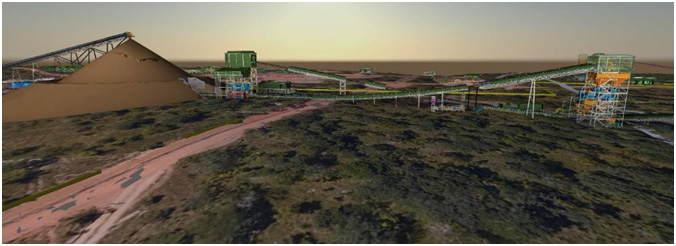
A 3-D model of Kakula’s processing plant mill feed end.
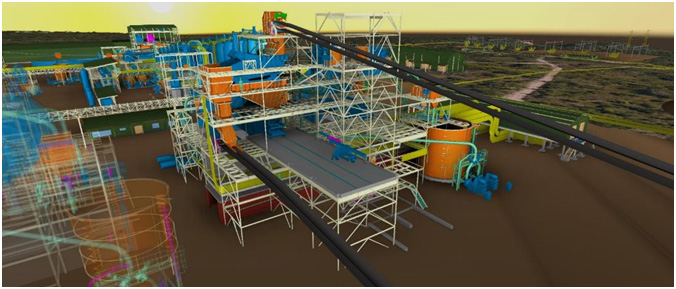
A 3-D model of Kakula’s processing plant flotation area.
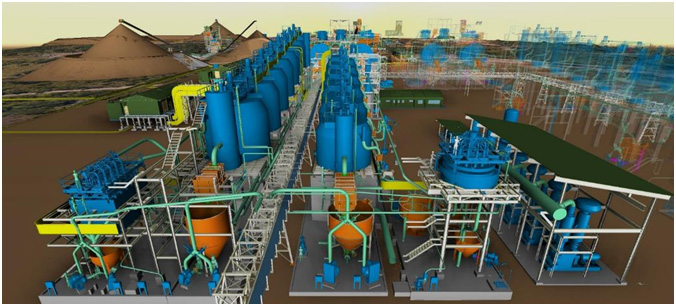
A 3-D model of Kakula’s processing plant concentrate thickening filtration and bagging plant.
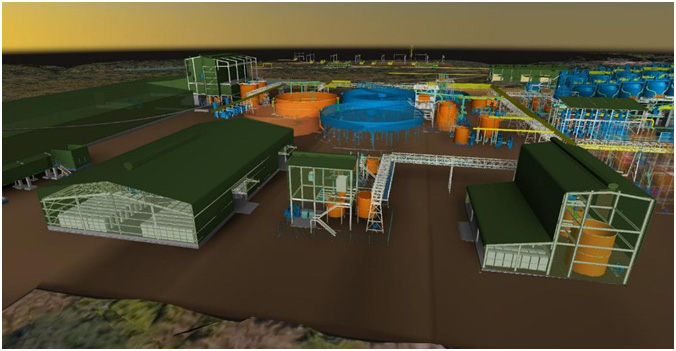
The current primary construction focus which runs through the project’s critical path is the installation of the underground rock handling system, the processing plant and the electrical high-voltage infrastructure installation.
The contract for the 220-kilovolt overhead power line, as well as the contract for the new electrical substation has been awarded. Construction of the new road linking Kamoa-Kakula with the Kolwezi airport is progressing well with three of the six culverts completed. The road is expected to be operational by the end of 2019. Construction of the first 360 beds at the Kakula site accommodation is ongoing, with the first beds having been delivered on time and the remaining units to be completed in early 2020.
Exploration success leads to discovery of shallow thick ultra-high grade Kamoa North Bonanza Zone
Drilling in Q3 2019 focused on the extension and definition of the Kamoa North Bonanza Zone. In total, 18,103 metres were completed in 69 holes.
Ultra-high-grade mineralization previously identified over an approximately 600 metre strike length was further defined in Q3 2019 on 50-metre east-west spaced sections at 20-metre to 25-metre spaced centres, approximately 300 metres east and west of the discovery hole DD1450 (13.05% copper over 22.3 metres (true thickness)).
Beyond the central core of the Bonanza Zone, drilling was done on wider 100-metre spaced section lines to fully define the limits of the system. This drilling constrains the shallow portion of the Central Bonanza Zone. However, the zone remains untested along considerable strike length on the western side of the West Scarp Fault.
The completed drill holes currently are being sampled for dispatch to Bureau Veritas and final assay results are expected in Q4 2019. These assay results will be used in an updated Mineral Resource estimate for the Kamoa North area, including the Bonanza Zone.
Figure 6: Conceptual model of the Bonanza Zone.
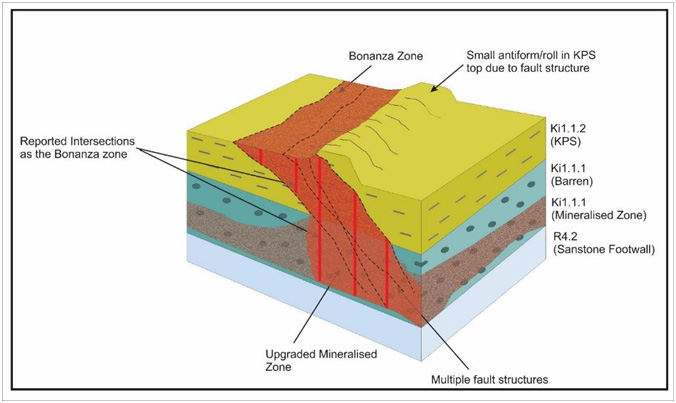
Figure 7: Grade profiles plotted on the same scale show the significance of the grades between the different discovery areas on the Kamoa-Kakula Project.
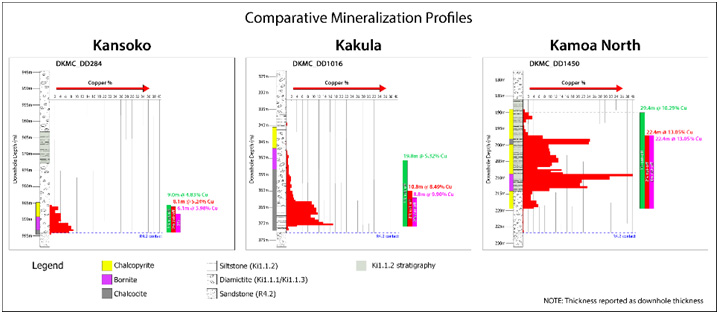
Development options at Kamoa North being considered; development drilling and test work underway
Given the shallow depth, remarkable thickness and massive copper sulphide mineralization discovered within the Kamoa North Bonanza Zone, Kamoa-Kakula’s engineers are evaluating potential options to accelerate the development of this new discovery.
Geotechnical and hydrogeological drilling is underway to provide support for future mining studies. A number of metallurgical composites also have been generated for existing coarse reject material that will be used for flotation test work.
Ongoing upgrading work enables Mwadingusha hydropower station to supply clean electricity to the national grid
Ongoing upgrading work at the Mwadingusha hydropower plant in the DRC has significantly progressed with major equipment being delivered on site. The power station was shut down to replace sections of penstocks that were found to be in an advanced stage of corrosion. The progressive re-commissioning of the turbines, fully refurbished and modernized with state-of-the-art control and instrumentation, is underway and is expected to be completed in Q3 2020. The refurbished plant is projected to deliver approximately 72 megawatts (MW) (72,000 kilovolts) of power to the national power grid.
The work at Mwadingusha, part of a program to eventually overhaul and boost output from three hydropower plants, is being conducted by engineering firm Stucky of Lausanne, Switzerland, under the direction of Ivanhoe Mines and Zijin Mining, in conjunction with the DRC’s state-owned power company, La Société Nationale d’Electricité (SNEL). Once fully reconditioned, the three plants will have a combined installed capacity of approximately 200 MW of electricity for the national grid, which is expected to be more than sufficient for the Kamoa-Kakula Project.
The Kansoko Mine, Kakula Mine and Kamoa camp have been connected to the national hydroelectric power grid since the completion of a 12-kilometre, 120-kilovolt, dual-circuit power line between Kansoko and Kakula in December 2017. The design of permanent, 11-kilovolt reticulation to the ventilation shafts and mine has started, which includes substations, overhead lines and surface cables.
Assembling of the new turbines at Mwadingusha in progress.
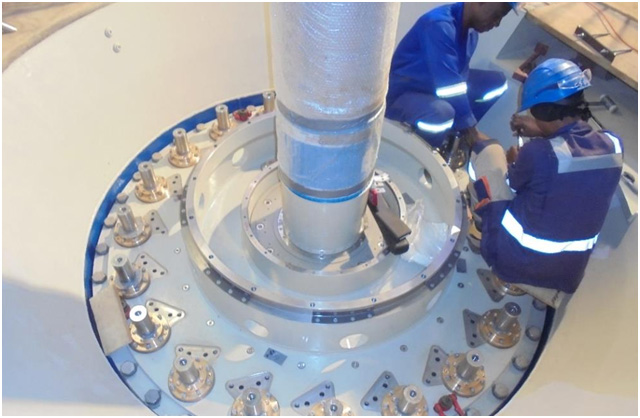
Continued focus on community and sustainability
The Kamoa-Kakula Sustainable Livelihoods Program is committed to sustainable development in the communities within the project’s footprint. The main objective of the livelihoods program is to enhance food security and living standards of the people who reside within the project’s footprint. The program consists primarily of fish farming, poultry production, beekeeping and food crops, including farming of maize (corn), vegetables and bananas. With the increase in development activities at the project, a significant number of employment opportunities have also been made available to residents of the local communities.
Additional non-farming related activities for Q3 2019 included education and literacy programs, the continuation of a community brick-making program, the construction of a school, the construction of housing for teachers, and the supply of fresh water to a number of local communities using solar powered boreholes. Community members also have been trained by community health experts to maintain the sanitation of the water boreholes in their communities.
Adult literacy education is an important part of the Kamoa-Kakula community skills development program.
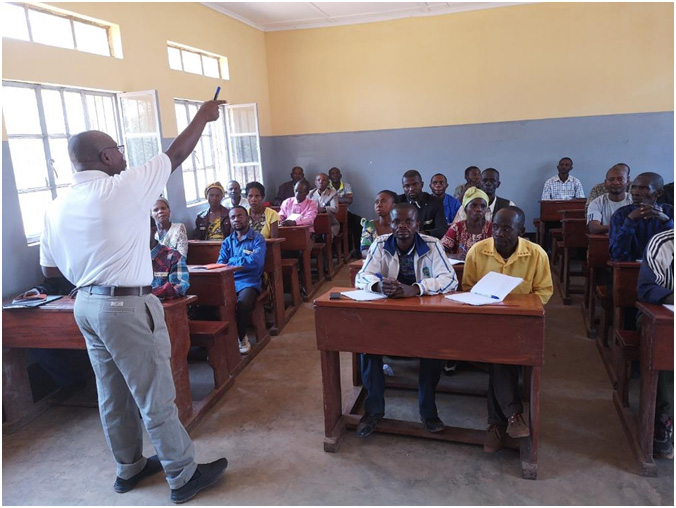
4.Western Foreland Exploration Project
100%-owned by Ivanhoe Mines
Democratic Republic of Congo
Drilling on Ivanhoe’s 100%-owned Western Foreland licences, immediately north of the Kamoa-Kakula mining licence, has discovered the extension of the Kamoa Far North high-grade shallow copper corridor on Ivanhoe’s wholly-owned licences for at least 800 metres
Ivanhoe’s DRC exploration group is targeting Kamoa-Kakula-style copper mineralization through a regional drilling program on its 100%-owned Western Foreland exploration licences located to the north, south and west of the Kamoa-Kakula Project.
Drilling on the Kiala licence, PR706, immediately north of the northern border of the Kamoa-Kakula mining licence, has confirmed the extension of the Kamoa Far North high-grade trend onto Ivanhoe’s 100%-owned Western Foreland exploration licences for at least 800 metres to date.
Three additional east-west section lines located at 600 metres, 800 metres and 1,000 metres north of the Kamoa-Kakula mining licence have been drill tested at 100-metre intervals during Q3 2019. Visually strong copper mineralization has been intersected in drilling on the first two of these section lines, with drilling ongoing on the third section line. Observed mineralization is consistent in downhole depth and stratigraphic location with that reported previously along this high-grade trend. Sixteen holes have been completed in this new discovery area with pending assays expected to be returned in Q4 2019.
Figure 8: Location of recent drilling results in the Kamoa Far North Exploration Area and the Kamoa Far North extension on Ivanhoe’s 100%-owned Western Foreland exploration licences.
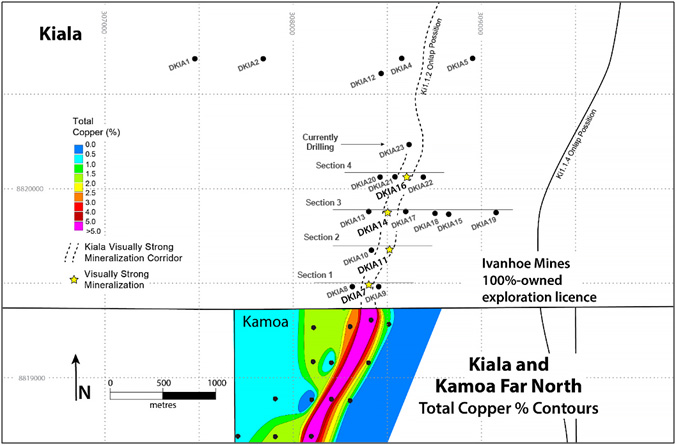
A total of 23 shallow drill holes, with depths of less than 150 metres, were completed on the Makoko, Kisua and Kikuyu licences during Q3 2019 using the project-owned Toyota Land Cruiser mounted drill rigs. This drilling was primarily to confirm stratigraphic contacts identified in the airborne magnetics or to test prospective horizons.
Geophysics to assist with target generation
A high-resolution airborne magnetic survey was completed over the Makoko and Kiala prospects around Kamoa-Kakula, as well as over Ivanhoe’s Lufupa South East Blocks (Musinga-Kisua, Kikuyu-Kikando, Kengere-Kasara). The data acquisition has been completed and the team currently is analyzing and interpreting the data for geological and structural interpretation and target delineation (see Figure 9).
Ground-gravity surveys were conducted at the Kengere and Makoko prospects to assist with target generation. In the Kiala area, an extension to the east of the previously completed grid also was undertaken to provide better resolution at the margin of the Nguba basin.
Figure 9: Ivanhoe Mines Exploration Licences in Western Foreland and Lufupa South East shows areas with recently acquired high resolution airborne magnetic data.
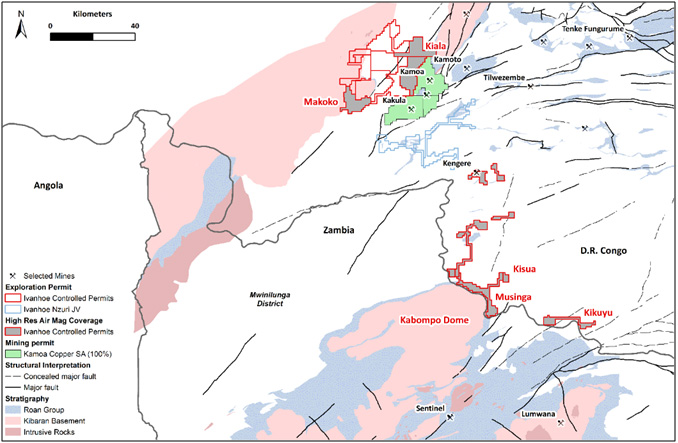
SELECTED QUARTERLY FINANCIAL INFORMATION
The following table summarizes selected financial information for the prior eight quarters. Ivanhoe had no operating revenue in any financial reporting period and did not declare or pay any dividend or distribution in any financial reporting period.
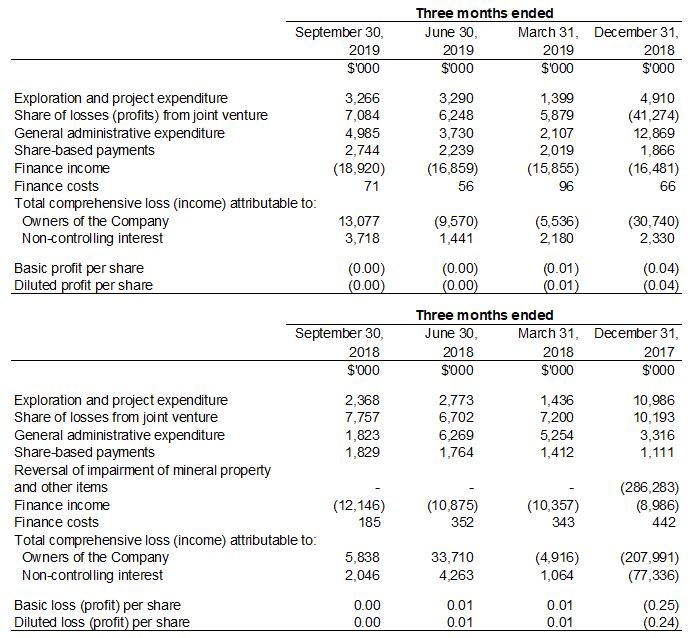
DISCUSSION OF RESULTS OF OPERATIONS
Review of the three months ended September 30, 2019 vs. September 30, 2018
The company recorded a total comprehensive loss of $16.8 million for Q3 2019 compared to a loss of $7.9 million for the same period in 2018. The majority of the loss in Q3 2019 mainly was due to an exchange loss on translation of foreign operations of $17.7 million resulting from the weakening of the South African Rand by 7% from June 30, 2019, to September 30, 2019. The company recognized an exchange loss on translation of foreign operations in Q3 2018 of $5.2 million.
Finance income for Q3 2019 amounted to $18.9 million, and was $6.8 million more than for the same period in 2018 ($12.1 million). The increase mainly was due to interest earned on loans to the Kamoa Holding joint venture to fund operations as the accumulated loan balance increased. This interest amounted to $13.8 million for Q3 2019, and $10.4 million for the same period in 2018. Interest received on cash and cash equivalents also increased to $3.5 million for Q3 2019 compared to $1.2 million in Q3 2018, due to a higher cash balance during Q3 2019.
Exploration and project expenditure for Q3 2019 amounted to $3.3 million and was $0.9 million more than for the same period in 2018 ($2.4 million). With the focus at the Kipushi and Platreef projects being on development and the Kamoa-Kakula Project being accounted for as a joint venture, all exploration and project expenditure in both periods related to exploration at Ivanhoe’s 100%-owned Western Foreland exploration licences.
The company’s share of losses from the Kamoa Holding joint venture decreased from $7.8 million in Q3 2018 to $7.1 million in Q3 2019. The following table summarizes the company’s share of the losses of Kamoa Holding for the three months ended September 30, 2019, and for the same period in 2018:
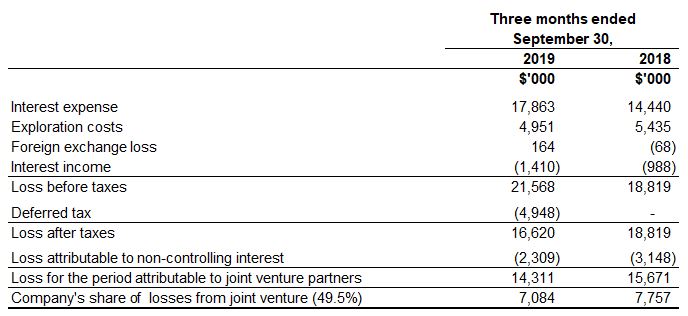
Review of the nine months ended September 30, 2019 vs. September 30, 2018
The company recorded a total comprehensive loss of $5.3 million for the nine months ended September 30, 2019 compared to a loss of $42.0 million for the same period in 2018. The company recognized a loss on translation of foreign operations of $11.9 million for the nine months ended September 30, 2019 and $23.9 million for the same period in 2018, mainly due to the weakening of the South African Rand over these periods.
Finance income for the nine months ended September 30, 2019 amounted to $51.6 million, and was $18.2 million more than for the same period in 2018 ($33.4 million). The increase mainly was due to interest earned on loans to the Kamoa Holding joint venture to fund operations that amounted to $38.5 million in 2019, and increased by $9.7 million when compared to the same period in 2018 as the accumulated loan balance increased. Interest received on cash and cash equivalents also increased from $2.9 million for the nine months ended September 30, 2018 to $9.6 million for the same period in 2019 due to a higher cash balance in 2019.
Exploration and project expenditure for the nine months ended September 30, 2019 amounted to $8.0 million and was $1.4 million higher than for the same period in 2018 ($6.6 million). Exploration and project expenditure in both periods related to exploration at Ivanhoe’s 100%-owned Western Foreland exploration licences.
The company’s share of losses from the Kamoa Holding joint venture decreased to $19.2 million for the nine months ended September 30, 2019, from $21.7 million for the same period in 2018. The following table summarizes the company’s share of the profits and losses of Kamoa Holding for the nine months ended September 30, 2019, and for the same period in 2018:
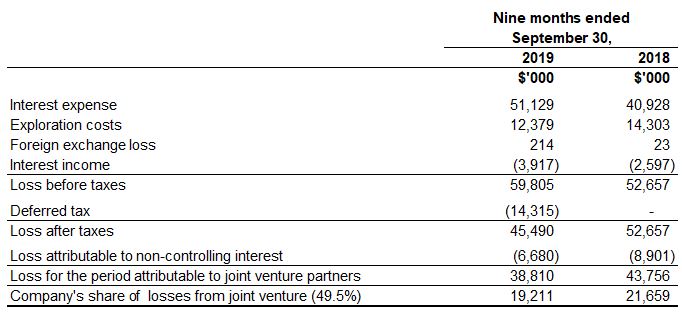
Financial position as at September 30, 2019 vs. December 31, 2018
The company’s total assets increased by $520.2 million, from $1,884.8 million as at December 31, 2018, to $2,405.0 million as at September 30, 2019. The increase mainly was due to the proceeds received on completion of the second equity investment by CITIC Metal Africa Investments Limited (CITIC Metal Africa) and Zijin exercising its anti-dilution rights, for total proceeds of $509 million.
Cash and cash equivalents increased by $234.4 million to $808.4 million as at September 30, 2019, from $574.0 million as at December 31, 2018. The company utilized $17.4 million of its cash resources in its operations and received interest of $9.6 million during the nine months ended September 30, 2019.
The net increase of property, plant and equipment amounted to $78.8 million, with a total of $90.6 million being spent on project development and to acquire other property, plant and equipment. Of this total, $40.2 million and $49.4 million pertained to development costs and other acquisitions of property, plant and equipment at the Platreef Project and Kipushi Project respectively.
The main components of the additions to property, plant and equipment − including capitalized development costs − at the Platreef and Kipushi projects for the nine months ended September 30, 2019, and for the same period in 2018, are set out in the following table:
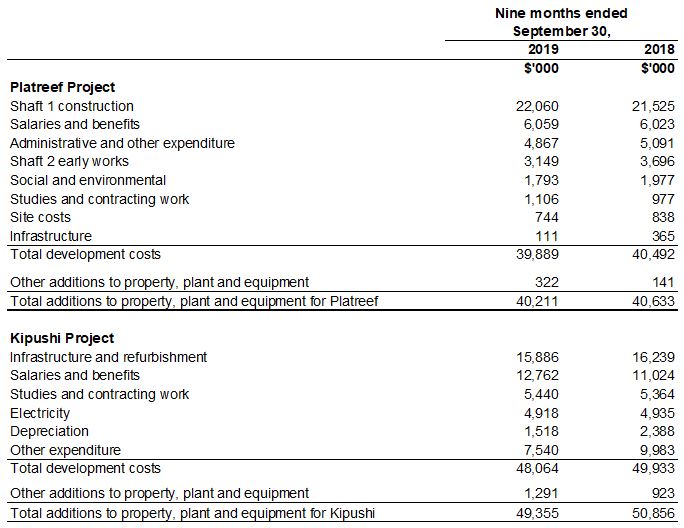
Costs incurred at the Platreef and Kipushi projects are deemed necessary to bring the projects to commercial production and are therefore capitalized as property, plant and equipment.
The company’s investment in the Kamoa Holding joint venture increased by $140.1 million from $681.7 million as at December 31, 2018 to $821.8 million as at September 30, 2019 with each of the current shareholders funding the operations equivalent to their proportionate shareholding interest. The company’s portion of the Kamoa Holding joint venture cash calls amounted to $120.9 million during the nine months ending September 30, 2019, while the company’s share of losses from the joint venture amounted to $19.2 million.
The company’s investment in the Kamoa Holding joint venture can be broken down as follows:

The Kamoa Holding joint venture principally uses loans advanced to it by its shareholders to advance the Kamoa-Kakula Project through investing in development costs and other property, plant and equipment, as well as continuing with exploration. This can be evidenced by the movement in the company’s share of net assets in the Kamoa Holding joint venture which can be broken down as follows:

The Kamoa Holding joint venture’s net increase in property, plant and equipment from December 31, 2018 to September 30, 2019 amounted to $176.4 million and can be further broken down as follows:
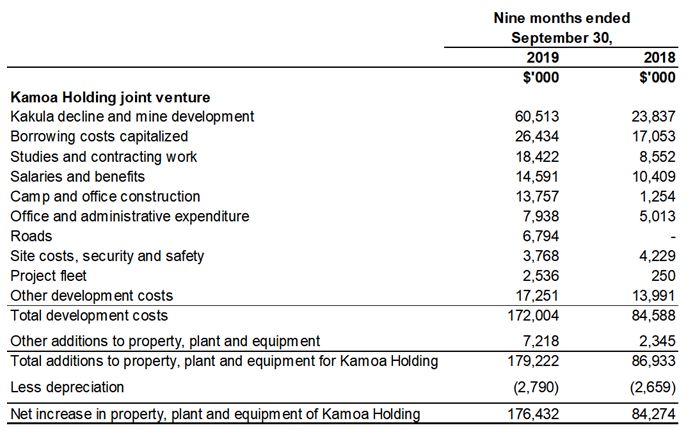
The company extended a secured loan of $50 million to High Power Exploration Inc. (HPX), a subsidiary of I-Pulse Inc., in April 2019. The loan has a two-year maturity and an interest rate of 8% per annum. The principal amount of the loan and accrued interest is convertible in whole, or part, by Ivanhoe at its sole discretion into shares of treasury common stock of HPX and/or a subsidiary of HPX. The loan is secured by a pledge of shares of an HPX subsidiary in the United States which is pursuing a Tier One copper-gold exploration and development project.
On adoption of IFRS 16 on January 1, 2019, the company recognized a right-of-use asset of $15.1 million and a lease liability of $15.1 million. The company’s total liabilities increased by $7.3 million to $73.3 million as at September 30, 2019, from $66.0 million as at December 31, 2018, with the recognition of the lease liability being the reason for the increase.
LIQUIDITY AND CAPITAL RESOURCES
The company had $808.4 million in cash and cash equivalents as at September 30, 2019. At this date, the company had consolidated working capital of approximately $798.0 million, compared to $562.9 million at December 31, 2018.
The private placement transaction with CITIC Metal Africa, a direct subsidiary of CITIC Metal Co., Ltd. (CITIC Metal), announced on April 25, 2019, was completed on August 16, 2019. The company received gross proceeds of C$612 million ($459 million) from CITIC Metal Africa and issued 153,821,507 common shares to CITIC Metal Africa through the private placement at a price of C$3.98 per share. Zijin Mining Group Co., Ltd., exercised its existing anti-dilution rights, which yielded additional proceeds to the company of C$67 million ($50 million), also at a price of C$3.98 per share.
Since December 8, 2015, each shareholder in Kamoa Holding has been required to fund Kamoa Holding in an amount equivalent to its proportionate shareholding interest. The company is advancing Crystal River’s portion on its behalf in return for an increase in the promissory note due to Ivanhoe.
The Platreef Project’s current expenditure is being funded solely by Ivanhoe, through an interest bearing loan to Ivanplats, as the Japanese consortium has elected not to contribute to current expenditures.
The company’s main objective for the remainder of 2019 at the Platreef Project is the continuation of Shaft 1 construction. At Kipushi, the principal objectives are the completion of the feasibility study and continued upgrading of mining infrastructure. At the Kamoa-Kakula Project, priorities are the continuation of development at Kakula, where expenditure has been increased in order to achieve the planned initial copper concentrate production from the Kakula Mine, currently scheduled for the third quarter of 2021. The company has forecasted to spend $15 million on further development at the Platreef Project; $12 million at the Kipushi Project; $4 million on regional exploration in the DRC; and $8 million on corporate overheads for the remainder of 2019 – as well as its proportionate funding of the Kamoa-Kakula Project, expected to be $86million for the remainder of 2019.
As Ivanhoe continues to advance its projects, representatives of Ivanhoe have reviewed and assessed numerous alternatives to finance its share of construction costs for the Kamoa-Kakula Copper Mine and to advance exploration and development initiatives at its other projects in Southern Africa. These alternatives include, but are not limited to, existing liquidity sources, including cash, receivables and investments, selling assets, project financing, streaming or royalty transactions, equipment financing, and accessing lines of credit. While Ivanhoe expects that it will continue to have sufficient cash resources or project-related financing options available to cover its share of the initial capital costs at the Kamoa-Kakula Mine, the company will continue to seek out and review opportunities presented to Ivanhoe, having regard to the best interests of Ivanhoe as well as Ivanhoe’s operations and financial position, industry conditions and geopolitical considerations.
This news release should be read in conjunction with Ivanhoe Mines’ 2019 Third Quarter Financial Statements and Management’s Discussion and Analysis report available at www.ivanhoemines.com and at www.sedar.com.
Qualified Persons
Disclosures of a scientific or technical nature regarding the revised capital expenditure and development scenarios at the Kamoa-Kakula Project in this news release have been reviewed and approved by Steve Amos, who is considered, by virtue of his education, experience and professional association, a Qualified Person under the terms of NI 43-101. Mr. Amos is not considered independent under NI 43-101 as he is the Head of the Kamoa Project. Mr. Amos has verified the technical data disclosed in this news release.
Other disclosures of a scientific or technical nature in this news release have been reviewed and approved by Stephen Torr, who is considered, by virtue of his education, experience and professional association, a Qualified Person under the terms of NI 43-101. Mr. Torr is not considered independent under NI 43-101 as he is the Vice President, Project Geology and Evaluation. Mr. Torr has verified the other technical data disclosed in this news release.
Ivanhoe has prepared a current, independent, NI 43-101-compliant technical report for each of the Platreef Project, the Kipushi Project and the Kamoa-Kakula Project, which are available under the company’s SEDAR profile at www.sedar.com:
- The Kamoa-Kakula Integrated Development Plan 2019 dated March 18, 2019, prepared by OreWin Pty Ltd., Amec Foster Wheeler E&C Services Inc. (a division of Wood PLC), DRA Global, SRK Consulting (South Africa) (Pty) Ltd. and Stantec Consulting International LLC, covering the company’s Kamoa-Kakula Project;
- The Platreef 2017 Feasibility Study Technical Report dated September 4, 2017, prepared by DRA Global, OreWin Pty. Ltd., Amec Foster Wheeler, Stantec Consulting, Murray & Roberts Cementation, SRK Consulting, Golder Associates, and Digby Wells Environmental, covering the company’s Platreef Project; and
- The Kipushi 2019 Mineral Resource Update dated March 28, 2019, prepared by prepared by OreWin Pty Ltd., MSA Group (Pty) Ltd., SRK Consulting (South Africa) (Pty) Ltd., and MDM (Technical) Africa Pty Ltd. (a division of Wood PLC), covering the company’s Kipushi Project.
These technical reports include relevant information regarding the effective dates and the assumptions, parameters and methods of the mineral resource estimates on the Platreef Project, the Kipushi Project and the Kamoa-Kakula Project cited in this news release, as well as information regarding data verification, exploration procedures and other matters relevant to the scientific and technical disclosure contained in this news release in respect of the Platreef Project, Kipushi Project and Kamoa-Kakula Project.
Information contacts
Investors
Bill Trenaman +1.604.331.9834
Website www.ivanhoemines.com
Forward-looking statements
Certain statements in this news release constitute “forward-looking statements” or “forward-looking information” within the meaning of applicable securities laws. Such statements and information involve known and unknown risks, uncertainties and other factors that may cause the actual results, performance or achievements of the company, its projects, or industry results, to be materially different from any future results, performance or achievements expressed or implied by such forward-looking statements or information. Such statements can be identified by the use of words such as “may”, “would”, “could”, “will”, “intend”, “expect”, “believe”, “plan”, “anticipate”, “estimate”, “scheduled”, “forecast”, “predict” and other similar terminology, or state that certain actions, events or results “may”, “could”, “would”, “might” or “will” be taken, occur or be achieved. These statements reflect the company’s current expectations regarding future events, performance and results and speak only as of the date of the company’s Q3 2019 MD&A.
Such statements include without limitation, the timing and results of: (i) statements regarding first copper concentrate production at the Kakula Mine in Q3 2021; (ii) statements regarding the capacity of Kakula’s processing plant modules increasing by 26%, from 3.0 Mtpa to 3.8 Mtpa, significantly boosting projected early-stage copper production; (iii) statements regarding the completion of the rebalancing transaction by which Zijin Mining will increase its shareholding to approximately 13.88%; (iv) statements regarding the planned pre-production stockpiles at Kakula of approximately 1.5 million tonnes of high-grade ore and an additional 700,000 tonnes of material grading approximately 1% to 3% copper should allow the plant to ramp up quickly and maintain a steady state volume of 3.8 Mtpa; (v) statements regarding the updated estimate of Kakula’s initial capital costs is approximately $1.3 billion as of January 1, 2019, which assumes commissioning of the processing plant in Q3 2021; (vi) statements that once the expanded mining rate of 18 Mtpa is achieved, Kamoa-Kakula is projected to become the world’s second largest copper mine, with peak annual production of more than 700,000 tonnes of copper; (vii) statements regarding the expected completion of Platreef’s Shaft 1 to a final depth of approximately 1,000 metres is planned for mid-2020; (viii) statements regarding Platreef’s Shaft 2 will have an internal diameter of 10 metres and will be equipped with two Koepe winding plants, one equipped with 40-tonne rock-hoisting skips with a capacity to hoist a total of six million tonnes of ore per year; (ix) statements regarding Ivanhoe’s investigation of an alternative early production plan for the Platreef Project, targeting significantly lower initial capital, to accelerate first production by using Shaft 1 as the mine’s initial production shaft, followed by expansions to the production rate as outlined in the DFS; (x) statements regarding the three development stations in Platreef’s Shaft 1 will provide initial, underground access to the high-grade orebody, enabling mine development to proceed concurrently with the construction of Shaft 2; (xi) statements regarding the planned mining methods at Platreef will use highly productive, mechanized methods, including long-hole stoping and drift-and-fill mining, and that each method will utilize cemented backfill for maximum ore extraction; (xii) statements regarding an independent definitive feasibility study (DFS) for the Kakula Mine is underway with an expected completion date of mid-2020, and at the same time, Ivanhoe expects to issue an updated preliminary economic assessment for the expanded Kamoa-Kakula combined production scenario that will include an updated Mineral Resource estimate for Kamoa North, including the initial Mineral Resource estimate for the Kamoa North Bonanza Zone; (xiii) statements regarding the forthcoming Kakula DFS will incorporate detailed design, engineering and procurement, with the plans to increase the initial processing plant ore capacity by approximately 26% from 3.0 Mtpa to 3.8 Mtpa; (xiv) statements that based on the results of the February 2019 PFS, Kakula’s average feed grade over the first five years of operations is projected to be 6.8% copper, and 5.5% copper on average over a 25-year mine life, and an increase in the initial processing plant throughput is expected to result in improved cash flows, which may be used to accelerate subsequent expansions; (xv) statements regarding Ivanhoe’s expectation that it will continue to have sufficient cash resources or project-related financing options available to cover its share of the potential increase in initial capital costs; (xvi) statements regarding the progressive re-commissioning of the turbines at the Mwadingusha hydropower plant in the DRC, fully refurbished and modernized with state-of-the-art control and instrumentation, is underway and is expected to be completed in Q3 2020, and that the refurbished plant is projected to deliver approximately 72 megawatts of power to the national power grid; (xvii) statements regarding the work at Mwadingusha is part of a program to eventually overhaul and boost output from three hydropower plants in the DRC that once fully reconditioned will have a combined installed capacity of approximately 200 MW of electricity for the national grid, which is expected to be more than sufficient for the Kamoa-Kakula Project; (xviii) statements regarding the completed drill holes from the Kamoa North Bonanza Zone currently are being sampled for dispatch to Bureau Veritas and final assay results are expected in Q4 2019; (xix) statements regarding that the pending assays from the sixteen drill holes completed in the new discovery area on the Kiala exploration licence are expected to be returned in Q4 2019; (xx) statements regarding the expected expenditure for the remainder of 2019 of $15 million on further development at the Platreef Project; $12 million at the Kipushi Project; $4 million on regional exploration in the DRC; and $8 million on corporate overheads for the remainder of 2019 – as well as its proportionate funding of the Kamoa-Kakula Project, expected to be $86 million for the remainder of 2019.
As well, all of the results of the pre-feasibility study for the Kakula copper mine and the updated and expanded Kamoa-Kakula Project preliminary economic assessment, the feasibility study of the Platreef Project and the pre-feasibility study of the Kipushi Project, constitute forward-looking statements or information, and include future estimates of internal rates of return, net present value, future production, estimates of cash cost, proposed mining plans and methods, mine life estimates, cash flow forecasts, metal recoveries, estimates of capital and operating costs and the size and timing of phased development of the projects. Furthermore, with respect to this specific forward-looking information concerning the development of the Kamoa-Kakula, Platreef and Kipushi projects, the company has based its assumptions and analysis on certain factors that are inherently uncertain. Uncertainties include: (i) the adequacy of infrastructure; (ii) geological characteristics; (iii) metallurgical characteristics of the mineralization; (iv) the ability to develop adequate processing capacity; (v) the price of copper, nickel, zinc, platinum, palladium, rhodium and gold; (vi) the availability of equipment and facilities necessary to complete development; (vii) the cost of consumables and mining and processing equipment; (viii) unforeseen technological and engineering problems; (ix) accidents or acts of sabotage or terrorism; (x) currency fluctuations; (xi) changes in regulations; (xii) the compliance by joint venture partners with terms of agreements; (xiii) the availability and productivity of skilled labour; (xiv) the regulation of the mining industry by various governmental agencies; (xv) the ability to raise sufficient capital to develop such projects; (xiv) changes in project scope or design, and (xv) political factors.
This news release also contains references to estimates of Mineral Resources and Mineral Reserves. The estimation of Mineral Resources is inherently uncertain and involves subjective judgments about many relevant factors. Estimates of Mineral Reserves provide more certainty but still involve similar subjective judgments. Mineral Resources that are not Mineral Reserves do not have demonstrated economic viability. The accuracy of any such estimates is a function of the quantity and quality of available data, and of the assumptions made and judgments used in engineering and geological interpretation (including estimated future production from the company’s projects, the anticipated tonnages and grades that will be mined and the estimated level of recovery that will be realized), which may prove to be unreliable and depend, to a certain extent, upon the analysis of drilling results and statistical inferences that ultimately may prove to be inaccurate. Mineral Resource or Mineral Reserve estimates may have to be re-estimated based on: (i) fluctuations in copper, nickel, zinc, platinum group elements (PGE), gold or other mineral prices; (ii) results of drilling; (iii) metallurgical testing and other studies; (iv) proposed mining operations, including dilution; (v) the evaluation of mine plans subsequent to the date of any estimates and/or changes in mine plans; (vi) the possible failure to receive required permits, approvals and licences; and (vii) changes in law or regulation.
Forward-looking statements and information involve significant risks and uncertainties, should not be read as guarantees of future performance or results and will not necessarily be accurate indicators of whether or not such results will be achieved. A number of factors could cause actual results to differ materially from the results discussed in the forward-looking statements or information, including, but not limited to, the factors discussed under “Risk Factors” and elsewhere in the company’s MD&A, as well as unexpected changes in laws, rules or regulations, or their enforcement by applicable authorities; the failure of parties to contracts with the company to perform as agreed; social or labour unrest; changes in commodity prices; and the failure of exploration programs or studies to deliver anticipated results or results that would justify and support continued exploration, studies, development or operations.
Although the forward-looking statements contained in this news release are based upon what management of the company believes are reasonable assumptions, the company cannot assure investors that actual results will be consistent with these forward-looking statements. These forward-looking statements are made as of the date of this news release and are expressly qualified in their entirety by this cautionary statement. Subject to applicable securities laws, the company does not assume any obligation to update or revise the forward-looking statements contained herein to reflect events or circumstances occurring after the date of this news release.
The company’s actual results could differ materially from those anticipated in these forward-looking statements as a result of the factors set forth in the “Risk Factors” section and elsewhere in the company’s Q3 2019 MD&A, unaudited condensed consolidated interim financial statements for the three and nine months ended September 30, 2019 and its Annual Information Form.



 English
English Français
Français 日本語
日本語 中文
中文